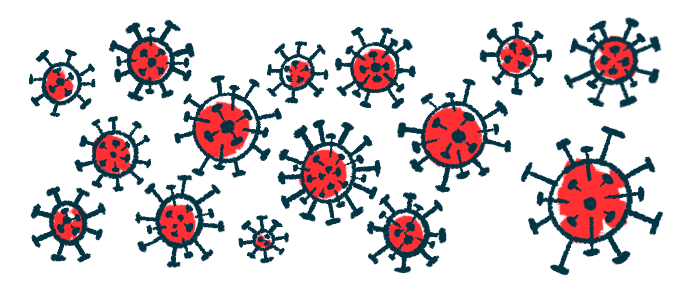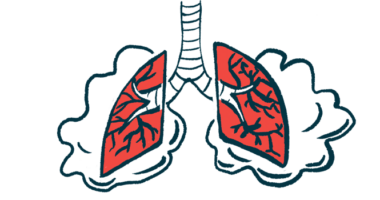Trikafta Reduces Harmful Microbial Load in CF Airways After 1 Year
Significant improvements seen in body weight, lung function in patients

Trikafta (elexacaftor, tezacaftor, and ivacaftor) was found to successfully lessen the microbial load in the airways of people with cystic fibrosis (CF) after one year of therapy, according to a new study.
Treatment with the approved triple therapy markedly reduced the abundance of Pseudomonas aeruginosa and Staphylococcus aureus, two harmful bacteria commonly found in CF lungs. It also improved the diversity of commonly-found microbes.
For patients, it also resulted in sizable gains in body weight and lung function as early as three months after starting Trikafta.
Longer studies now are needed to determine whether these effects are sustainable and protect against harmful re-infection, the researchers noted.
The microbial study, “Impact of Elexacaftor/Tezacaftor/Ivacaftor Therapy on the Cystic Fibrosis Airway Microbial Metagenome,” was published in the journal Microbiology Spectrum.
In CF, mutations in the CFTR gene lead to defects in the encoded CFTR protein, resulting in the abnormal buildup of thick mucus in various organs. Among the organs affected are the lungs, intestines, pancreas, and liver.
Trikafta is a CFTR modulator combination therapy designed to correct multiple defects in the CFTR protein.
It is marketed by Vertex Pharmaceuticals and is available to CF patients who carry one or two F508del mutations in the CFTR gene, the most common CF-causing genetic defect. The therapy has been shown to substantially improve patients’ lung function and quality of life.
Breaking the infection cycle in CF
Chronic airway infections are a common complication of CF that give rise to a harmful cycle of infection, inflammation, and tissue damage that impacts long-term outcomes and quality of life. Although the composition of the bacterial communities in CF airways has been widely studied, microbes found in the CF lung consist not only of bacterial species but also viruses and fungi.
Whole-genome shotgun sequencing (WGS) is a genetic analysis technique used to identify all types of microbes, not just bacteria, called the metagenome.
This report, by researchers based at the Hannover Medical School, in Germany, described the impact of one year of Trikafta on the microbial metagenome in the airways of CF patients using WGS.
The team enrolled 31 people — 18 female and 13 male — with CF. The patients ranged in age from 12.1 to 44.8 years, with a median age of 16.2. All were pancreatic insufficient, a CF complication that occurs when the pancreas does not make enough digestive enzymes. Among them, 18 carried one and 13 had two F508del mutations.
Microbial samples were collected before Trikafta treatment, and again, about four and 13 months later, from induced sputum or deep cough airway swabs. Initial assessment found that 11 participants were chronically infected with P. aeruginosa.
Clinical responses to Trikafta after 14 weeks, or just longer than three months, showed highly significant improvements in body weight, lung function, and CFTR biomarkers. These improvements were maintained at a 50-week (about one year) assessment.
GWS before Trikafta exposure was able to distinguish between patients able to produce sputum after induction, those who were more likely to carry harmful microbes — such as P. aeruginosa, S. aureus, and Haemophilus influenzae — and those who failed to produce sputum.
A single species dominated the airways of 10 individuals, meaning a relative abundance of more than 50% of the total abundance.
After 14 weeks of Trikafta, most participants failed to produce sputum; as such, the airway metagenome was primarily assessed by deep cough swabs after inhalation.
Trikafta’s effect on microbial load
The airway metagenome was found to predominantly consist of commonly-occurring species such as Prevotella, Rothia, Streptococcus, and Veillonella spp. Still, the dominance of single species decreased overall, including the abundance of P. aeruginosa and S. aureus.
After one year of Trikafta, the microbe abundance patterns for all patients became even more homogenous, or similar, with no dominant species and balanced with a high proportion of common species.
In the 10 patients with a highly dominant single species before treatment, less than 5% of species were considered rare. After 14 weeks, and even more so after one year, these patients had a higher proportion of rare species — median of 15% after 14 weeks and of 37% after 50 weeks.
Before Trikafta, seven of the patients were infected with P. aeruginosa, which was markedly reduced by 14 weeks of treatment, with most showing no detectable P. aeruginosa. Similar results were seen in 11 patients infected with S. aureus and 11 with H. influenzae. In six individuals, H. influenzae DNA was newly detected at 14 weeks and one year after testing negative before treatment.
“We consider it encouraging that [Trikafta] combination therapy can convert the two major CF pathogens [P. aeruginosa and S. aureus] into rare members of the CF airway microbial community,” the researchers wrote.
A comparison between metagenome data and clinical characteristics found worse lung function significantly correlated with a higher abundance of P. aeruginosa and S. aureus, lower H. influenzae, and reduced microbial diversity. Moreover, P. aeruginosa correlated positively with older age and higher bacterial load.
Elevated sweat chloride concentration, a marker for defective CFTR protein, correlated with a higher S. aureus abundance and increased total bacterial load. Worse nasal potential difference scores, also a CFTR function test, were associated with total bacterial load and lower microbial diversity.
Finally, the team measured the impact of Trikafta on microbial co-occurrence network, defined as a connection between different microbes based on their presence together. After 14 weeks of treatment, there was a single co-occurrence network. In contrast, before treatment and after one year, the co-occurrence network was more fragmented.
“We should remain cautious with long-term extrapolation, because the cooccurrence network was strongly stabilized intermittently after 3 months of triple therapy but 9 months later had disintegrated into fragments that now more resembled the network pre-[Trikafta],” the team wrote.
Overall, the study “demonstrates that combination therapy with [Trikafta] is successful in reducing the load with S. aureus and P. aeruginosa and converting the airway microbiota into a community of [commonly-found microbes] 3 and 12 months after initiation of therapy,” the researchers concluded, although “the microbial network remained vulnerable to fragmentation.”
“Long-term studies will have to assess whether the impressive gain of CFTR function results in sustainable changes in the airway microbial metagenome toward decreased [microbial imbalance], as a key determinant of disease progression in CF lung disease,” the researchers wrote.









